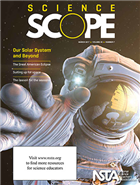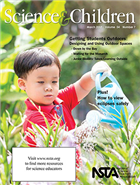Ideas and inspiration from NSTA’s March 2017 K-12 journals
By Mary Bigelow
Posted on 2017-03-16
Regardless of what grade level you teach, you the resources in this month’s journals can help make this summer’s eclipse a memorable occasion for your students. Not all students will be back to school on August 21, so this spring is a good time to spark their interest and provide resources.
Each issue includes the 2016 Outstanding Science Trade Books for Students K–12.
 The Science Teacher — Eclipse
The Science Teacher — Eclipse
“Planetary science is well worth revisiting in our high schools, if only to give students better understanding and appreciation of the majestic Sun-Earth-Moon system we experience every day,” according the TST editor. Especially since many for many high school students, there most recent exposure to Earth and Space Science may have been in middle school (or earlier). This summer’s eclipse is a good context to revisit and expand their experiences.
The lessons described in the articles include connections with the NGSS.
- Total Eclipse shows how this event can be an opportunity for 3-dimensional learning.
- Modeling the Eclipse has ideas for studying eclipses through observations, planetarium and virtual modeling, as well as mathematical and physical modeling,
- The authors of Chasing Shadows suggest that the upcoming eclipse is also an opportunity for students to study exoplanets and astronomical transits.
- In The Future of Energy, students use scientific argumentation to compare, analyze, and evaluate energy sources.
- Better Formative Assessment describes ways to analyze and assess student learning (and misconceptions).
- Science 2.0: Help Students Become Global Collaborators through citizen science projects.
- The Green Room: How Climate Change Affects Our Diet has resources to study the impact of climate change on crops, fishing, and other parts of the global food supply.
- Introducing students to the laws of physics can be done without an emphasis on computation. Focus on Physics: Teaching Physics as the Rules of Nature illustrates resources and graphics.
For more on the content that provides a context for projects and strategies described in this issue, see the SciLinks topics Climate Change, Eclipses, Food Crops, Life on Other Planets, Moon Phases, Planets, Sustainable Agriculture, Sunspots, Torricelli.
Continue for Science Scope and Science and Children.
 Science Scope – Our Solar System and Beyond
Science Scope – Our Solar System and Beyond
“Helping students understand the celestial mechanics behind a solar eclipse is just one way that you explore our solar system to better appreciate how our home planet fits into the big picture.” From the Editor’s Desk: When a Shadow Sheds Light
Featured articles in this issue that describe lessons include a helpful sidebar (“At a Glance”) documenting the big idea, essential pre-knowledge, time, and cost. The lessons also include connections with the NGSS.
- Are You Dressed for a Spacewalk? Harnessing Student Interest in Space Exploration to Engage Them in Energy and Engineering taps into students’ interest in space with an engineering project to design a “space suit.”
- Even if you’re not in the path of the eclipse, The August 2017 Total Solar Eclipse: The Perfect Opportunity to Highlight Three-Dimensional Science Learning has ideas for helping students understand phases of the moon, partial eclipses, and why they occur so infrequently.
- Make your astronomy activities more inclusive with the ideas and resources in Skynet Junior Scholars: Authentic Astronomy for All, Including Deaf and Hard-of-Hearing Students
- Moving Students Toward a More Accurate View of the Solar System goes beyond misconceptions about the size and scope of the solar system with modeling, questioning, and observing.
- Sunrise, Sunset: Using Personal Observations to Understand Changing Sun Patterns from an Earth Perspective looks at the positions of the Earth and sun and changes that can be observed.
- Citizen Science: Out of this World Citizen Science—Sun, Space, and Your Mission: Starlight describes a project from the Royal Society of Chemistry in which students around the world share their data from investigations into UV light.
- Disequilibrium: The Bernoulli Bag has a 5E lesson that shows the principle in action.
- Our colleagues share their resources and ideas in this month’s Listserv Roundup: Four Stellar Modeling Resources for Those Who Teach About the Sun and Solar System
- Scope on the Skies: Beyond Earth’s Orbit has background information on the topic.
- “Reasons for the seasons” is a classic study of student misconceptions, as described in Teacher to Teacher: Tackling Misconceptions About Seasons
For more on the content that provides a context for projects and strategies described in this issue, see the SciLinks topics Astronomy, Bernoulli’s Principle, Eclipses, Phases of the Moon, Seasons, Solar System, Space Exploration, Sun, Telescopes, UV Index
 Science & Children – Getting Students Outdoors
Science & Children – Getting Students Outdoors
“Whether it is a small plot of grassy area, the blacktop around the school, a park
down the street, a vast field, or a deck constructed over a marsh … get students outdoors.” The articles this month show interdisciplinary activities and learning experiences that take advantage of students’ interest in their surroundings.
The lessons described in the articles include connections with the NGSS.
- “Sometimes, creating an outdoor space means using existing natural spaces for creative and engaging experiences” such as those described in Down by the Bay — with ideas for other local studies.
- Waiting for the Monarch illustrates how to combine gardening with a study of butterflies and their metamorphosis, in the context of studying biodiversity.
- Junior BioBlitz Takes Learning Outside for elementary students and their communities as they learn about local biodiversity. The Early Years: Exploring Biodiversity has ideas for similar activities with young children.
- Our OASIS shows how to connect elementary and high school students through a summer science camp. The camp agenda is included, along with planning suggestions.
- Preparing for the Eclipse and Eclipses and Eye Safety have suggestions for viewing and studying the upcoming eclipse safely.
- Teaching Through Trade Books: Adaptations for Survival has two 5E lessons (and related books) for learning about plant adaptations for spreading seeds and animal adaptations for surviving harsh habitats as well as changing habitats.
- Science 101: Does the Weather Affect Your Body? What effects do temperature, humidity, air pressure have?
For more on the content that provides a context for projects and strategies described in this issue, see the SciLinks topics Adaptations of Animals, Biodiversity, Butterflies, Eclipse, Environment, Factors Affecting Plant Growth, Fossils, Marine Ecosystems, Metamorphosis, Weather
Disclaimer: The views expressed in this blog post are those of the author(s) and do not necessarily reflect the official position of the National Science Teaching Association (NSTA).


